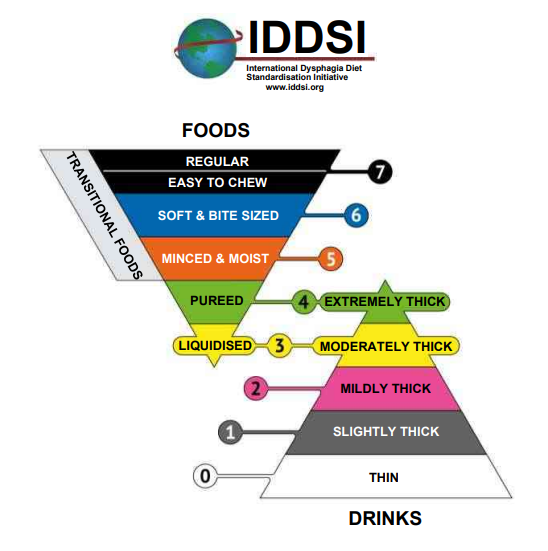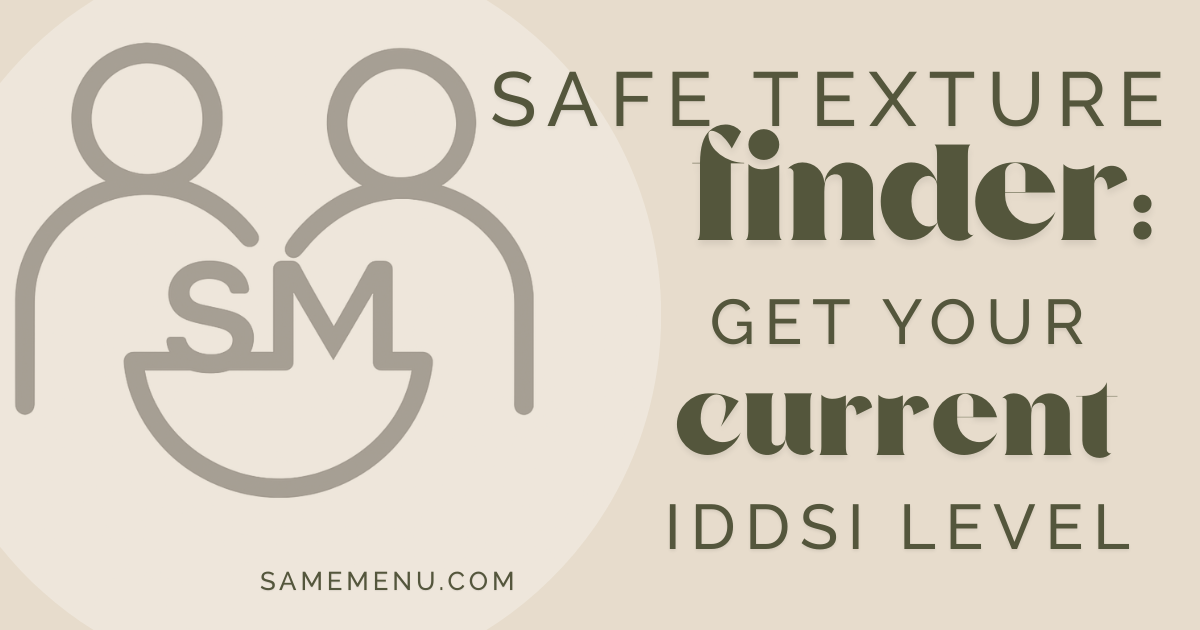There is no such thing as too much urgency when it comes to seeking assistance with difficulty with chewing and swallowing. However, some don’t see a speech-language pathologist (SLP) until weeks after symptoms begin. These weeks, no doubt, feel magnitudes longer, as the concern rarely stops when standing up from the table. I want to offer a glimpse into the clinical way that dysphagia is managed, that way you can make the decisions that feel best for you until you can receive an evaluation, or return to your prior way of eating.
This is a temporary self-check tool to help you choose safer food textures until you can work with a speech-language pathologist (SLP). It does not replace a professional swallowing evaluation.
Before starting:
Sitting upright is the best position to be eating in; it makes it easier to keep foods and liquids from falling back before you’re ready for the swallow and uses gravity to your advantage to help with the transition from the mouth to the throat. Be sure to schedule yourself enough time to eat your trials in a way that you feel in control of, not rushing. It may take some time of sitting with the foods to feel ready to take a bite; there is no pace but your own.
Since this activity will likely include some extra effort than you’ve been used to, it’s generally advised to avoid distractions. Some folks do find that listening to music, watching shows can ultimately help as a warm up or a positive association. We will get into ways of setting space for everyday meals a little later but many find it best to keep your concentration on the task at hand when trialing new textures.
Since our bodies are made up of so much water, yours is really good at working to reroute and use water when it shows up unexpectedly. Despite the fact that it might feel challenging due to the speed it will flow, water is safe for people with swallowing difficulties. Any water that could go down the “wrong pipe” gets absorbed easily by your lungs, so keep water nearby and use it to help gain confidence in your swallow*.
Once you’re set up, start by identifying the ladder step that most accurately fits the types of textures that you are safely and confidently managing. Just like with a ladder in real life, it is often best to take each step as it comes along, with the bottom level being the easiest to access. The first step on the food texture ladder is International Dysphagia Diet Standardization Initiative (IDDSI) level Liquidized 3 and ends at IDDSI level Regular 7, which means no modifications at all.
Due to the fact that there are multiple steps to the typical swallowing process, its very common that a food that feels simple for one reader will be particularly challenging for another. This is a reality that speech-language pathologists (chewing and swallowing specialists) had to consider when creating the IDDSI levels as a great starting point. When you work with an SLP, you will get even more specific insight into the types of modifications that will best fit your specific swallow.
For each step there will be a simple description (click here for more details on IDDSI Levels), a way to test that your food fits this level, and some types of foods that are commonly found in this level (although as my recipes will show you, there’s always a way to share the same menu!).
For people who are currently using liquids only for nutrition, start with Puree 4 for your “challenge” level.

Liquidized |3| Extremely Thick
What it means: Drinkable from a cup, cannot be molded or piped because it will not hold a shape, can be swallowed directly.
How to test it: It will slide off a tilted spoon easily, a fork cannot leave a pattern in its surface, and the bite drips slowly through its prongs.
Foods that tend to fit: Runny purees, some sauces and gravies, nutrition shakes.
Pureed |4| Moderately Thick
What it means: Completely smooth, no lumps, no chewing needed. It will stay together on a spoon.
How to test it: Load a bite onto a spoon and then tilt it over the plate. The food should slide off in one piece when you tilt the spoon. Scoop a bite with a fork and hold level; the puree should not flow through the spaces between the fork tines.
Foods that tend to fit: Yogurts, puddings, mashed potatoes, blended cottage cheese or soups.
Minced & Moist 5
What it means: Soft, small pieces (4mm) that are easy to mash with your tongue.
How to test it: All pieces should fit between the tines of a fork, and when pressed, pieces should squash easily with light pressure (your thumb nail doesn’t blanche).
Foods that tend to fit: Finely minced meats and vegetables braised in a sauce, cottage cheese, soft scrambled eggs.
Soft & Bite-Sized 6
What it means: Tender pieces (15mm) you can chew with light pressure.
How to test it: Pieces can fit within the width of all of a fork’s tines, a knife is not required to cut this food, when pressed it breaks apart, changes shape and doesn’t go back.
Foods that tend to fit: Cooked peeled vegetables and beans, fish, and peeled ripe fruits, ground meats.
Easy to Chew 7
What it means: Skip hard, fibrous, tough foods.
How to test it: Fork side can cut food, when pressed it breaks apart, changes shape and doesn’t return to starting shape.
Foods that tend to fit: Soft sandwiches (bread may be a challenge), cooked fruits and vegetables, ground meats.
Once you have found where you are currently eating on the IDDSI ladder, you will also have an idea of where you can start experimenting and gradually giving yourself exposure to these textures.
If you find that you are eating across a couple of levels, consider the higher of the two the “challenge” level and consult the more in-depth reviews of IDDSI’s diet-texture levels to help find a pattern in your chewing or swallowing challenges. Having an idea of your current level will make it easier for you to work with the Same Menu recipes’ texture modifications to help you find greater nutritional variety and meals that keep you connected with your circles.
You may feel like you have a long journey back to how you were eating and drinking before. This level is not a final destination, this is the “you are here” sticker on the map. Spontaneous improvements are possible and probable with continued efforts. Give yourself the same set up that you did this time to optimize alertness, attention, and intention at each texture trial.
*Water trials are supported by research to be safe even when we know that the water has a high chance of going down toward the lungs. As long as the water and mouth it passes through are clean, water does not increase any safety risk.
Every recipe here is designed for texture sensitive eaters: from dysphagia to dental issues to picky eaters. Get recipe roundups and practical tips by joining the mailing list.
Images included in this article were created by IDDSI and are part of the free resources. The IDDSI Framework and Descriptors are licensed under the CreativeCommons Attribution-Sharealike 4.0 International License https://creativecommons.org/licenses/by-sa/4.0/

Leave a Reply